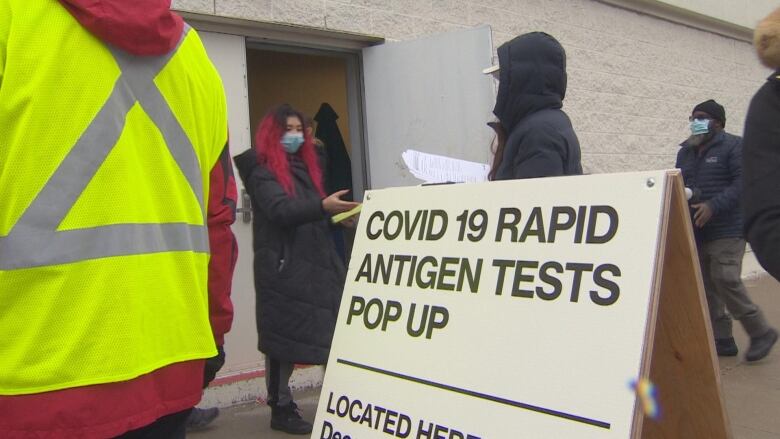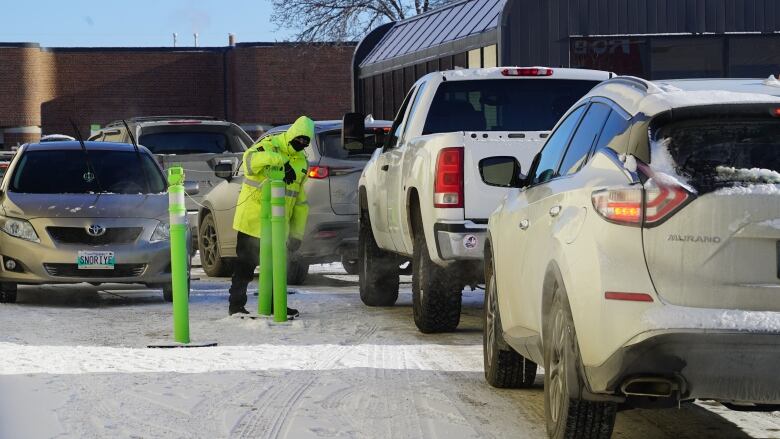Why are some isolation periods shortened for vaccinated people with COVID-19?
Isolation period changed from 10 days to 5 in certain provinces

This story idea came from audience members, like you, who got in touch with us. Send us all of your questions about COVID-19. We are listening:covid@cbc.ca.
British Columbia, Alberta, Saskatchewan, Manitoba, Ontario and New Brunswick have eachannounced shorter isolation periods for vaccinated individuals who test positive for COVID-19. The moves this week followsimilar measures fromthe U.S. Centers for Disease Control and Prevention (CDC) to also shorten the isolation period in the United States.
Under the new guidelines, vaccinated people who test positive with COVID-19 will only be required to self-isolate for a minimum of five days following the date when their symptoms started or a positive test, instead of 10 days. Some health officials have suggestedthe new ruleswill be easier for people to follow and help alleviateworker shortages.
If, after five days, their symptoms have improved or subsided for at least 24 hours, they can end the isolation period.But they still should bemasking and physical distancing.
And there are no changes to timelines for those who are unvaccinated.
Here's what you need to know about the new measures and the rationale behind the province's decisions.
What scientific evidence motivated these provinces to makethe change?
At Friday's announcement, Alberta Chief Medical Officer of Health Dr. Deena Hinshawsaid the move is "based on the evidence that those who are fully immunized shed virus for a shorter amount of time if they have a breakthrough infection."
Meanwhile in Ontario, Chief Medical Officer of Health Dr. Kieran Moore said Thursday that"90 per cent of your viral risk oftransmission isalready transpiredby five days."
In Ontario, testing is now limited tohigh-risk groupsand the province wants people to self-isolate if theydevelop symptoms. Rapid tests are sold out in many places and on back-order among many retailers.
"We know from studies thatif they have a rapid ascent, they will have a rapid descent in the amount of virus that they shed," Moore said.
He also said about 40 per cent of the spreadactually happens in the two days before you develop symptoms meaning you don't have the ability to protect people.
When asked about the change, Dr. Christopher Labos,a Montreal cardiologist with a degree in epidemiology,saidit's clear that "the further you get from the start of the infection, the less infectious you are."
He said he can understand the rationale behind the move but whether it's a good idea remains to be seen.
"I'm not sure that in the current context, when we have very very rapidly spreading Omicron variant, that this would be the time to really shorten those requirements," said Labos.
Dr. Lynora Saxinger, an infectious diseases specialist and associate professor at the University of Alberta,said the move is pragmaticin some ways.
"The idea of being able to contain infection by isolating people during that last period where they are relatively unlikely to spread it,when it is spreading so aggressivelyessentiallyeverywhere already, the additional benefit does become a little bit questionable," she said.

Raywat Deonandan, an epidemiologist and associate professor at the University of Ottawa, said the isolation changes are risky because they are based on an average and they could lead to infectious people mingling with healthy ones.
"Some can be infectious for three days, some for 12 days or longer," he said.
"The concerning part is that we have people who are re-entering society with suspected infection and infectiousness without a negative test to clear them."
Deonandan said rapid tests could be deployed strategically so that people can test themselves out of isolation.
What additionalreasons were given by the provinces?
Dr. Saqib Shahab,Saskatchewan's chief medical health officer, said Thursday that the shortened isolation period encourages more self-testing and interrupts chains of transmission in a more proactive way.
Hinshawsaid analysis shows that "shorter isolation periods are easier to comply with than longer ones.
"And themore people that comply with that isolation period, the better off we'll be and that can actually have an overall improved effect on limiting spread."
Alberta Health Minister Jason Copping was one of several officials who pointed to worker shortages.
"We're making these changes to help prevent disruptions in Alberta's workforce, especially for those who deliver the services Albertans count on," he said.
Hinshaw added the caveat that they don't have trials showing more people are likely to comply with five-day versus 10-day isolations, but said they're being guided by the science.
"If we felt that the viral shedding was not impacted [by vaccinations] this would not be the appropriate action to take," she said.

When do these changes take effect?
For Ontario and Saskatchewan, the changes are immediate. For B.C. and Manitoba, the new measures start Jan. 1; Alberta's change takes effect Jan. 3, with New Brunswick set to implement the measure on Jan. 4.
What are the symptoms people should be watching for?
Fever, chills, shortness of breath, cough, and sore throat are some of the main symptoms listed by public health units in B.C.,Ontario, Alberta, New Brunwsick, Manitoba and Saskatchewan.
What about householdand close contacts?
Guidance from each province is different. In Ontarioand New Brunswick, household contacts are also required to isolate alongside the individuals with COVID.
Alternatively,B.C. Public Healthasks people to self-monitor for 14-days after exposure.
ForSaskatchewanand Alberta,contacts who are fully vaccinated do not need to self-isolate unless symptomatic.
Manitoba's release did not specify the protocol regarding household contacts.CBCNews has reached out for comment, but had yet to receive a response by the time of publication.
How isolated should I remain during the five- or 10-day period?
Self-isolation or quarantining means people should stay at home and not see anyone.
More specifically, Saskatchewan says:
- Do not go to work or school.
- Do not go to public areas including places of worship, stores, shopping malls and restaurants.
- Do not have visitors in your home.
- Cancel or reschedule non-urgent appointments. Where possible, arrange virtual appointments.
- Do not take public transit.
- Ask family/friends to drop off food or use delivery services.
With files from Ryan Patrick Jones














_(720p).jpg)


 OFFICIAL HD MUSIC VIDEO.jpg)
.jpg)



























































































